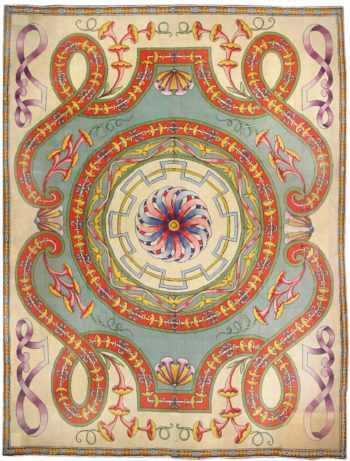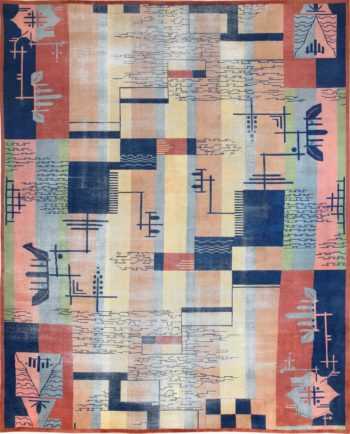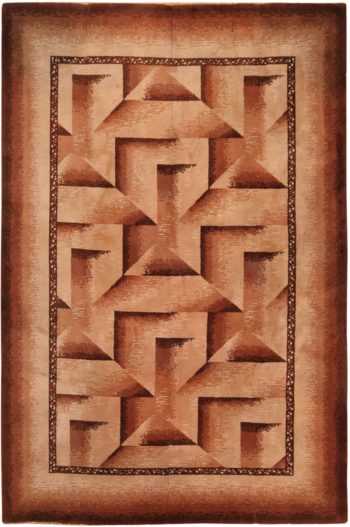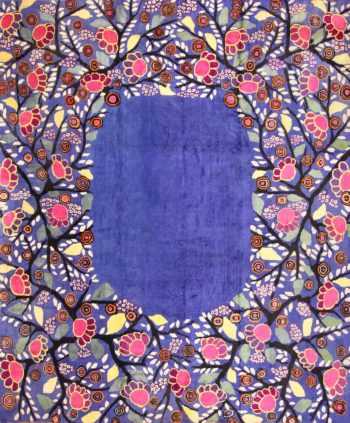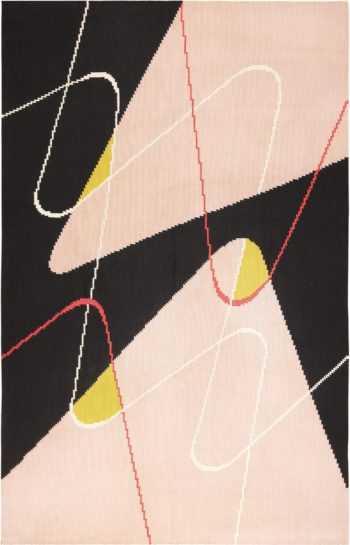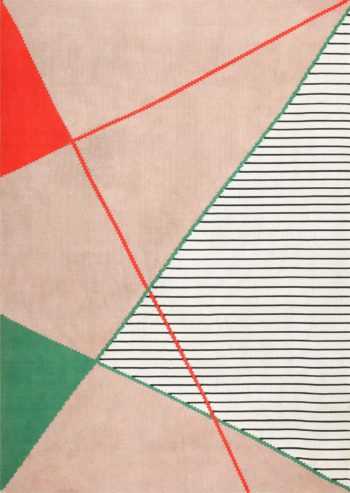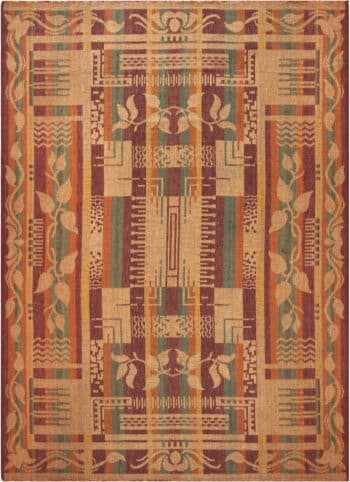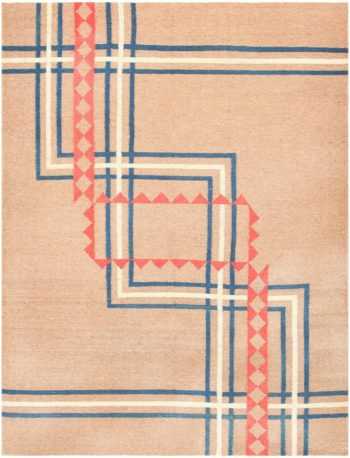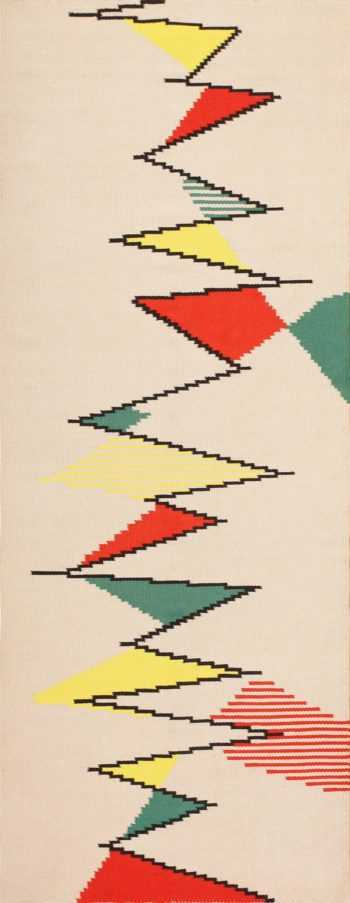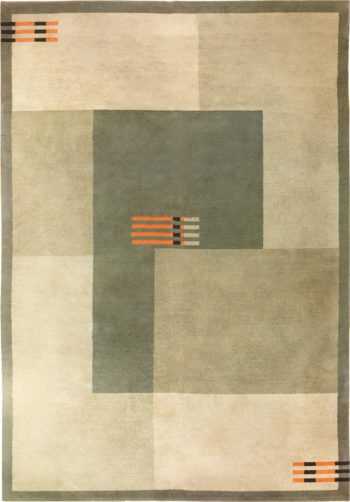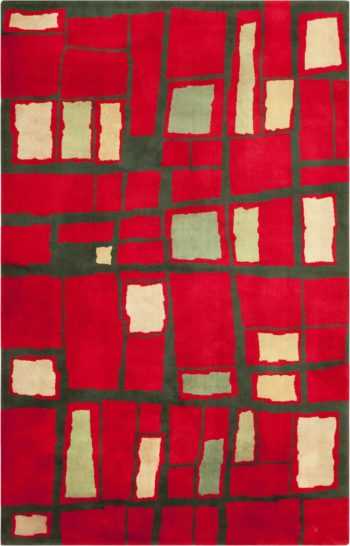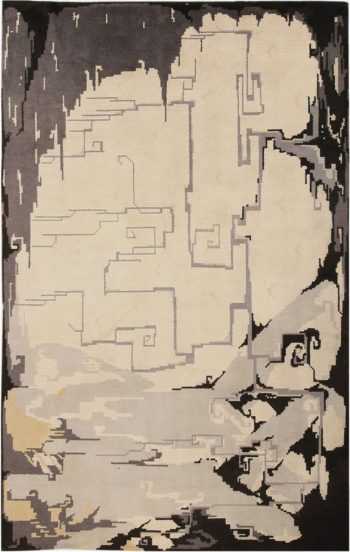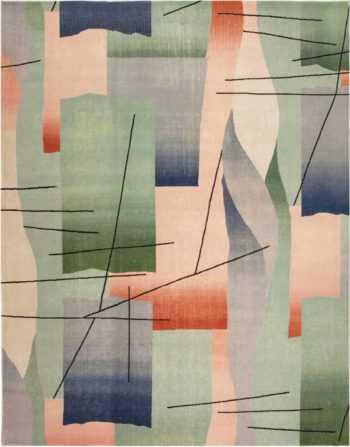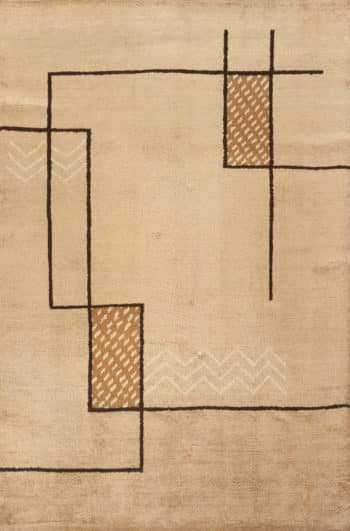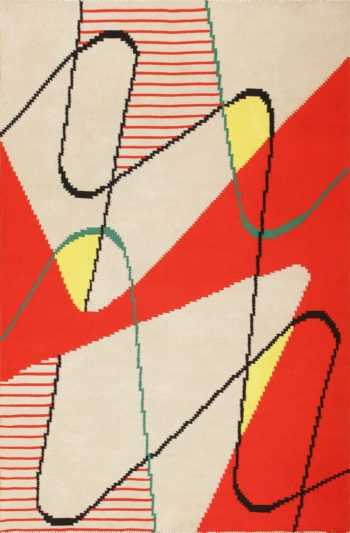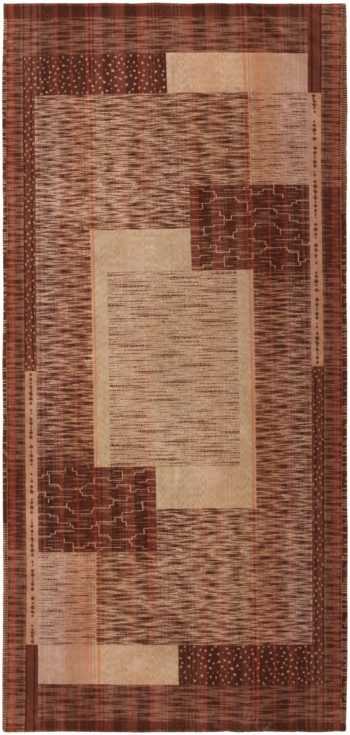Art Deco Rugs & Carpets Collection
Explore Our Exquisite Collection of Art Deco Inspired Rugs
Below you can view our current selection of beautiful Art Deco Rugs:
Beautiful Oversized Spanish Art Deco Design Carpet 50065
$220,000.00Size: 20 ft 4 in x 28 ft 2 in (6.2 m x 8.59 m)Large Size Antique Indian Art Deco Design Area Rug 44979
$120,000.00Size: 12 ft 7 in x 18 ft 7 in (3.84 m x 5.66 m)Jacques Emile Ruhlmann French Art Deco Carpet 47642
$125,000.00Size: 14 ft x 15 ft 7 in (4.27 m x 4.75 m)Large Antique Indian Shabby Chic Art Deco Rug 49386
$49,000.00Size: 12 ft 4 in x 15 ft (3.76 m x 4.57 m)Gorgeous Vintage French Art Deco Runner Rug 70969
$8,500.00Size: 3 ft x 14 ft 9 in (0.91 m x 4.5 m)Art Deco Design Wilton Rug 70074
$19,500.00Size: 8 ft 10 in x 13 ft 5 in (2.69 m x 4.09 m)Edouard Benedictus French Art Deco Rug 49214
$28,500.00Size: 10 ft 10 in x 13 ft 2 in (3.3 m x 4.01 m)Black And Cream Flat Woven Vintage French Art Deco Rug 49929
$21,000.00Size: 8 ft 4 in x 13 ft (2.54 m x 3.96 m)Large Antonin Kybal Room Size Vintage French Kilim Rug 48893
$24,000.00Size: 9 ft 6 in x 13 ft (2.9 m x 3.96 m)Vintage European Art Deco Kilim Rug 72828
$14,500.00Size: 9 ft 4 in x 12 ft 6 in (2.84 m x 3.81 m)Vintage Flat Weave Art Deco Design Kilim Rug From India 48030
$26,000.00Size: 9 ft x 11 ft 8 in (2.74 m x 3.56 m)Vintage Green French Art Deco Rug 46754
$24,000.00Size: 8 ft 1 in x 11 ft 2 in (2.46 m x 3.4 m)Gallery Size Vintage French Kilim Rug by Antonin Kybal 48892
$6,900.00Size: 4 ft 3 in x 10 ft 10 in (1.3 m x 3.3 m)Antique English Green Art Deco Carpet 72256
$18,500.00Size: 7 ft 4 in x 10 ft 5 in (2.24 m x 3.17 m)Vintage Art Deco Wilton Rug 46618
$8,600.00Size: 6 ft 7 in x 10 ft 2 in (2.01 m x 3.1 m)Vintage English Deco Rug by Hildo Krop 40289
$26,500.00Size: 6 ft 5 in x 10 ft 1 in (1.96 m x 3.07 m)Vintage Artistic Art Deco Deign Chinese Room Size Area Rug 46252
$14,500.00Size: 7 ft 9 in x 10 ft (2.36 m x 3.05 m)Geometric Antique Minimalist French Art Deco Design Area Rug 72576
$19,500.00Size: 6 ft 5 in x 9 ft 8 in (1.96 m x 2.95 m)Geometric French Art Deco Rug 72232
$21,500.00Size: 7 ft x 9 ft 8 in (2.13 m x 2.95 m)Vintage Antonin Kybal Room Size French Kilim Rug 48891
$18,500.00Size: 6 ft 4 in x 9 ft 7 in (1.93 m x 2.92 m)Antique Neutral Minimalist Art Deco French Rug 48457
$16,000.00Size: 6 ft 3 in x 9 ft 6 in (1.9 m x 2.9 m)Vintage French Art Deco Carpet 46878
Original price was: $8,800.00.$6,800.00Current price is: $6,800.00.Size: 5 ft x 9 ft (1.52 m x 2.74 m)Vintage French Art Deco Rug 46876
Original price was: $8,600.00.$6,600.00Current price is: $6,600.00.Size: 4 ft x 9 ft (1.22 m x 2.74 m)Antique French Art Deco Kilim 49256
$18,500.00Size: 7 ft 6 in x 8 ft 10 in (2.29 m x 2.69 m)
Learn More About Art Deco Rugs
What is an Art Deco rug?
An Art Deco rug refers to a type of rug or carpet that reflects the design principles and aesthetics of the Art Deco movement, which was prominent in the 1920s and 1930s. Art Deco is an influential design style characterized by geometric shapes, bold colors, and a sense of luxury and modernity. This style emerged in the decorative arts, architecture, and design, influencing various forms of artistic expression, including rugs and carpets.
Art Deco rugs typically feature geometric patterns, such as zigzags, chevrons, and stylized floral motifs. The color palette tends to be bold and contrasting, with strong combinations like black and white, or vibrant hues like red, blue, and gold. The materials used for these rugs often include wool or silk, contributing to a luxurious and refined feel.
The designs of Art Deco rugs can vary, but they commonly embody the symmetrical and streamlined characteristics associated with the Art Deco movement. These rugs were popular during the heyday of Art Deco and are still appreciated today for their stylish and timeless appeal.
Is “Art Deco” a time period or design style?
“Art Deco” refers to both a specific design style and a time period in the history of art and design. The term “Art Deco” is derived from the 1925 Exposition Internationale des Arts Décoratifs et Industriels Modernes held in Paris, where the style gained significant prominence.
As a design style, Art Deco is characterized by geometric shapes, bold colors, and decorative elements that convey a sense of luxury and sophistication. It emerged in the 1920s and 1930s, reaching its peak in popularity during the interwar period. Art Deco influenced various artistic disciplines, including architecture, interior design, visual arts, fashion, and industrial design.
Key features of the Art Deco style include:
- Geometric Shapes: The use of geometric shapes, such as zigzags, chevrons, and stepped forms, is a hallmark of Art Deco design.
- Symmetry: Art Deco often incorporates symmetrical arrangements, providing a sense of order and balance.
- Bold Colors: Vibrant and bold color palettes, including high-contrast combinations such as black and white, are typical in Art Deco design.
- Luxurious Materials: The use of luxurious materials, such as exotic woods, chrome, glass, and precious metals, reflects the opulence associated with the style.
- Streamlined and Modernist Influences: While Art Deco is known for its decorative elements, it also exhibits influences from the modernist movement, incorporating streamlined and simplified forms.
- Decorative Ornamentation: Intricate and decorative ornamentation, often featuring stylized motifs such as sunbursts, zigzags, and Egyptian or African-inspired designs, is a common characteristic.
- Influence on Multiple Disciplines: Art Deco influenced not only architecture and interior design but also fashion, graphic design, and the visual arts, creating a cohesive and distinctive aesthetic.
While Art Deco as a design style had its heyday in the 1920’s and 1930’s, its impact has endured, and elements of Art Deco design continue to be used and appreciated in contemporary contexts. Today, it remains a popular and influential design style with a timeless and elegant appeal.
What defines Art Deco style?
Art Deco is a distinctive and influential design style that emerged in the early 20th century, reaching its peak popularity in the 1920s and 1930s. It is characterized by a combination of various artistic and design elements, reflecting a blend of modernism, luxury, and a fascination with new technologies.
Several defining features of the Art Deco style include:
- Geometric Shapes: Art Deco design often incorporates geometric shapes, such as zigzags, chevrons, stepped forms, and repetitive patterns. Straight lines and symmetrical compositions are prevalent.
- Bold Colors: The color palette of Art Deco is bold and contrasting. Rich and vibrant colors like red, black, white, gold, and chrome are commonly used to create a sense of drama and luxury.
- Luxurious Materials: Art Deco embraces the use of high-quality and luxurious materials, such as exotic woods, lacquer, chrome, glass, and inlaid materials. These elements contribute to a sense of opulence and modernity.
- Symmetry: Symmetry is a key characteristic of Art Deco design. Buildings, furniture, and decorative arts often feature balanced and symmetrical arrangements, providing a sense of order and sophistication.
- Streamlined Forms: The style is known for its sleek and streamlined forms, influenced by the machine age and the desire for modernity. This is reflected in furniture design, architecture, and other decorative arts.
- Decorative Motifs: Art Deco incorporates stylized and decorative motifs, often drawing inspiration from ancient cultures, as well as nature. These motifs can include sunbursts, chevrons, stepped forms, and abstract representations of flora and fauna.
- Sunbursts and Zigzags: Sunburst patterns, zigzags, and chevrons are common motifs in Art Deco design. These motifs add dynamic and visually striking elements to the overall aesthetic.
- Influence on Various Art Forms: Art Deco influenced a wide range of artistic disciplines, including architecture, interior design, fashion, graphic design, and the decorative arts. The style often sought to blend traditional craftsmanship with modern materials and techniques.
- Elegance and Glamour: Art Deco is associated with a sense of elegance, glamour, and sophistication. It became particularly popular in the design of theaters, hotels, and other public spaces where a luxurious and modern atmosphere was desired.
Art Deco remains influential, and its timeless design elements continue to inspire contemporary designers across various disciplines.
What make the original art deco rugs so special?
Original Art Deco rugs are considered special and highly sought after for several reasons, each contributing to their unique appeal.
Here are some of the main reasons why the original art deco rugs considered so special:
- Historical Significance: Original Art Deco rugs were created during the heyday of the Art Deco movement in the 1920s and 1930s. They carry the historical and cultural significance of that era, capturing the spirit of a time marked by societal and artistic changes.
- Authentic Design: These rugs feature authentic Art Deco design elements, including geometric patterns, bold colors, and stylized motifs that are true to the principles of the Art Deco movement. The designs are often a reflection of the dynamic and innovative spirit of the time.
- Craftsmanship: Original Art Deco rugs were crafted with a high level of skill and attention to detail. Many of them were handmade using traditional weaving techniques, and the use of quality materials like wool or silk adds to their durability and luxurious feel.
- Limited Production: The original Art Deco rugs were produced during a relatively short period, and many were handmade or produced in limited quantities by skilled artisans. This limited production contributes to their rarity and desirability among collectors.
- Timeless Aesthetic: The Art Deco style has proven to be timeless. The bold geometric patterns and vibrant colors used in these rugs continue to be appreciated for their aesthetic appeal, making them suitable for both vintage and contemporary interiors.
- Versatility: Despite being rooted in a specific historical period, Art Deco rugs exhibit a versatility that allows them to complement various design styles. They can enhance both traditional and modern interiors, adding a touch of sophistication and character.
- Investment Value: Original Art Deco rugs have become valuable collector’s items. As with many vintage and antique pieces, their rarity and historical significance contribute to their investment value, making them attractive to those interested in both design and art market investments.
- Handmade Quality: Many original Art Deco rugs were crafted by skilled artisans using traditional hand-weaving techniques. The craftsmanship involved in their creation adds a level of quality and individuality that is often highly valued by collectors.
- Unique Patterns and Color Combinations: The distinctive patterns and color combinations used in Art Deco rugs set them apart. The designers of the time embraced bold and innovative combinations, resulting in rugs that stand out for their visual impact and originality.
Collectors, designers, and enthusiasts appreciate the special qualities of original Art Deco rugs, considering them not just as floor coverings but as pieces of art that reflect a unique era in design history.
More about the history of Art Deco rugs
The Deco period, which is also referred to as “style moderne”, was an international design movement from 1920’s to 1940’s. It produced a mix of many different styles borrowing design influences from neoclassical, constructionist, cubism, modernism and art nouveau. The Art Deco movement led to the evolution of the carpet revolution. Antique carpets made before the 1920’s, especially the more refined oriental carpets, did not compliment the modern decor and Art Deco furnishings. A new style was taking shape that reflected this movement.
Carpet design evolved from floral to angular elegance with modern, abstract and figurative motifs. The color palate is both bold and muted with interesting juxtapositions of light and dark. The design is frequently spare, geometric, and architectural with a luxurious feel. Such characteristics come together to create the aesthetics of a large swath of vintage rugs. Such legendary artists as Picasso, Poiret, Gray, Delaunay, Paul Klee, Paul and Dorn shaped this evolution. Paule Leleu, the daughter of Jules Leleu of the famed House of Leleu was a talented creator whose vision also contributed to these highly collectible rugs.
In the rug trade, term “Art Deco” or “Deco” (as in “Deco Rugs” for short) applies to European and certain Chinese carpets that reflect the new movements in modern European decorative arts during the first third of the twentieth century.
Art Deco Rugs are characterized by experimentation with bold colors, angular lines, and the omission of heavy ornamentation. Over the past few years, the demand for art deco rugs and art deco carpets has grown tremendously. Partly fueled by the revival of mid-century modernist interior design trends, Art deco rugs come from various regions in Europe but some of the most coveted pieces are the art deco carpets or rugs that were made in France, China and Scandinavia (which are really mid-century modern but when it comes to interior design the term art deco does fit in well). Since a rug need to be 80 years old or older to be called antique, in only a few more years, the art deco vintage rug could be be referred to as Antique Art Deco area rugs.
While the term Art Deco really refers to a movement / time period, most rug dealers will refer to any of the modernist rugs as art deco. So if you have your heart set on true deco rugs – then you might have to sort through some of the other types of “deco rugs” – which might not be a bad thing at all!
Deco rugs created in the dawn of the 20th century feature trendsetting designs that are daring and stylish today. These landmark pieces marked the transition from classical to modern. The result is a timeless style that remains elegant and refined. This innovative era in history produced many distinctive antique and semi-antique carpets that are exceptionally desirable. In the East and the West, creative geniuses conceived unimaginable patterns unlike anything seen before.
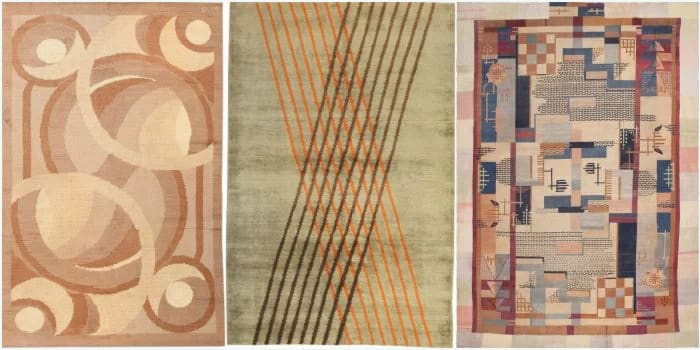
Art Deco Rugs Home Decor
European designers developed streamlined geometric compositions and expressive abstract patterns. The legacy of Scandinavia’s famous master weavers was just beginning when art deco was defined, and many fabulous mid-century designs grew out of this innovative and productive time.
In China, fine Oriental carpets were produced on an unprecedented scale. The rich colors, sophisticated details and Eastern-influenced designs featured in Chinese art deco rugs define the sleek, sophisticated style of this extraordinary era. For a timeless and modern home interior design that is posh, art deco rugs are the ultimate choice.
French Art Deco Rugs and Carpets From the 1920’s
Production emerged during a perfect storm of technology, political conditions and public demand that allowed the rug and the master weaver to rise to an unrivaled level of prominence. The French Art Deco rugs and carpets reflect modern elements paired with unique traditions inspired by individual artists. By the 1920’s, the vintage rugs featured bold designs that could become a focal point and statement piece rather than a pleasant background for furniture and other design pieces.
At the same time, anonymous firm-employed designers suffering in the economic environment following WWI became freelance weavers creating luxurious custom commissions for private clients. The French Art Deco rugs and carpets reached the height of their popularity between 1925 and 1937 with production falling dramatically due to the political instabilities that led up to WWII.
The roots of the French Art Deco rugs and carpets designs were laid during the turn of the century by the prevalent art nouveau and arts and crafts era carpets and furniture featured at the 1900 Exposition Universelle, which instigated the establishment of La Société des Artistes Décorateurs. The popularity of textiles and carpets designed by William Morris and his contemporaries paved the way for French Art Deco rugs and carpets that were created by designers with international name recognition.
In the years following the industrial revolution, great importance was placed on the role of industrial designers in the production of textiles, carpets and furniture. By 1915, industrial design schools and programs publicizing industrial design as a career path drastically increased the number of new minds entering the field in Belgium, Germany, France, the UK and the United States. In Germany, successful schools were established in Berlin, Munich, Leipzig and Cologne. The powerful Deutscher Werkbund, which hosted the 1914 Cologne Exhibition, inspired British interior designers to establish the competing Design and Industries Association (DIA) in 1915.
The international influence and expositions hosted by various design groups created an atmosphere charged with creativity. By 1915, the Österreichischer Werkbund and the Wiener Werkstatte were established in Austria and Vienna respectively; the Schweizerischer Werkbund in Switzerland and Sweden’s Slöjdföreningen handcrafting society adopted similar campaigns to advance their crafts based on the German model.
The Exposition Internationale des Arts Décoratifs of 1925 held in Paris represented the best of the best French Art Deco rugs and carpets and designs from the top designers and weavers around the world making art deco the premier design movement of the time.
The graphic rugs of US-born designer Marion Dorn and her husband Edward McKnight Kauffer woven in their London studio are among the carpets that epitomize the sweeping, angular style of art deco designs. Far away, the Chinese studio operated by Walter Nichols wove their own brand of art deco rugs and carpets while the Chinese-born ex-pat Betty Joel created unique designs for private clients.
The legendary Maison Myrbor studio in Northern Africa manufactured carpets for Joan Miro, Jean Lurcat and other French designers ranging from abstract Berbers decorated with tribal glyphs to fluid pictorials with mythical influences carried over from the ancient Greeks and remaining pre-Raphaelites.
In Paris, interior designers experimented symmetric and asymmetric geometric patterns with subtle monochrome colors and sharply contrasting palettes inspired by the color theories of Robert Delaunay. Eileen Gray also created art deco carpets to be produced by Evelyn Wyld as well as commercial studios. Gray’s abstract designs allowed weavers at the Maison Myrbor to experiment with alternative sisal-fiber pile in a looped chenille weave.
Popular Parisian weavers Hélène Henry and Germaine Montereau also experimented with new fibers and subtle monochrome carpets decorated with shadowed details created by textural half-pile and adapted velvet making techniques used to create shaggy poodle tufts.
As designs evolved, the minimalist vintage rug became tremendously popular decreasing the need for active designers. Following the 1937 Exposition of International Arts and Technology, members of the Union des Artistes Moderne (UAM), which included independent designers and the prominent ateliers of Aubusson, collectively declared, “the fate of French taste is in danger” due to the poor showing and drastic decline in overall carpet production.
With the threat of WWII and the closure of the Bauhaus School, rug production and design innovation was dampened. Although a limited number of art deco rugs were created through the 1940’s, the level of rug production incorporating master weavers and master designers did not recover.
Art Deco Rugs for Today’s Interior Design Trends
Art Deco Rugs – 2010’s is the decade of redecorating and making home a more welcoming place to live. With colors trending back towards classic, hopeful and neutral, now is the time to make your home more sophisticated. One trend for this year is the resurgence of mid century, vintage and Art Deco interiors.
Art Deco was central in the early 20th century and spanned from 1900 to the beginning of the second world war. This decorating style focused on furniture as art and finding unique ways to incorporate art into decoration.
Textiles are featured prominently and there were different types of wood, leather, and precious metals. The revival of Art Deco is bringing in some interesting color mixes: black with either green, red, or ashen.
Black lacquer wood and chrome are predominant materials in furniture construction, also ebony and light-maple woods as well. The upholstery fabrics are velor and other lush, comfortable fabrics. The furniture is basically novel and shiny yet comfortable and functional.
Popular Art Deco lighting fixtures that one would expect to see in such interiors include wall sconces, goblet shades, and bronze and flute lamps. Floral and numerical patterns are included in the actual construction as well. They match well with other accents which include nickel mirrors, fluted vases and bronze sculptures. Luscious textiles include leather which has a luxe, glossy look which suits Art Deco.
Antique Tapestries are a great compliment to Art Deco and modernist decors. It goes without said that a true vintage rug or antique carpet are making a comeback since the new production out there today will never have the patina and if you are going to invest in your interiors nothing will ever compare to the real thing.
Funnily enough, since the prices of many of the real McCoy’s are comparable to the new productions it simply begs the question – why not get the real thing? Besides the fact that the antique pieces simply look better, the new rugs and carpets have no real value once one acquires them just like a new car – once you buy it and drive it off the lot it’s resale value will plummet whereas the antique pieces will always retain some of their inherent value.
One always should start with the rug when decorating their house. Fabrics come in a wide range of colors, patterns and price ranges the options or almost limitless. Therefore it is always easier to find a nice fabric to match the rug but to go the other way around will be extremely difficult since finding the right rug might take longer and will probably cost more than the fabrics themselves.
So before you begin your interior design:
Start with the perfect carpet, and everything else will fall into place!
Colors: Classic Revival: a color palette of grey, mushroom, sky, desert, sand, taupe and white are a great starting point for elegance in your home. Hopeful: grassy green, vibrant violet, sunny yellow, warm tangerine, and soft pinks are colors which can assist you in evocatively creating a mood simply by selecting a new color scheme.
Bold yet subdued: ocean blue, tomato red, and amber gold are vibrant colors which can be welcoming yet are not overpowering for the occupant of the room.

